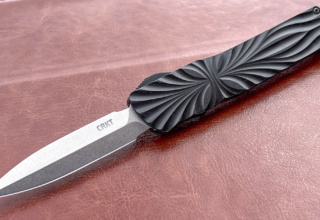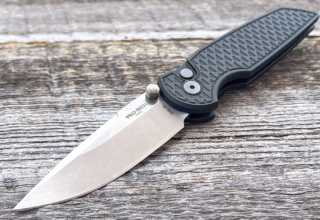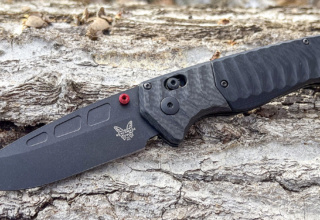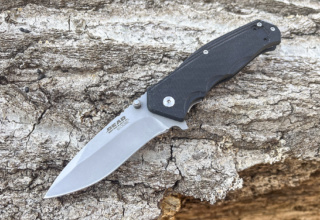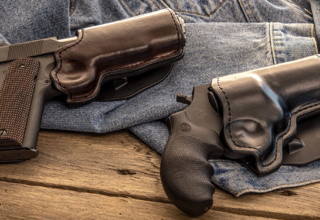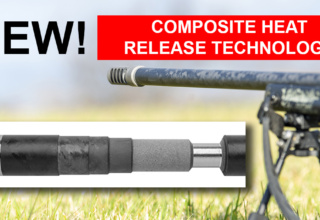Blades and handles may get all the glory, but understanding folder locking systems is key to buying the right knife for you.
by Dexter Ewing; photos by Marty Stanfield, Marty Stanfield Photography
Folding knives have become quite sophisticated in recent years. Advancements in materials, designs, and blade locking mechanisms have propelled this segment of the knife market into a viable category of its own.
The purpose of locking mechanisms is to make the knife safer to use when taking on heavy and tough cutting tasks. Simply put, they prevent the blade from accidentally folding up, preventing user injury.
One of the earliest known folding knives with a locking mechanism is the Buck 110 Folding Hunter. This iconic knife was such a successful seller for Buck.Not only was it a hit for hunters and outdoorsman but it also found its way onto the belts of those who most needed a rugged-built knife. This included tradesmen, law enforcement, and military folks. The 110 also spawned numerous variants by Buck’s competition—many are still made today. The sturdy back lock design of the 110 provided a solid lockup and required two hands to release and close.
Since then, blade locks have become more advanced by becoming not only stronger, but also more user friendly, where the blade could be unlocked with one hand only. This goes hand-in-hand with the multitude of one-hand-opening knives found on the market today. In this article, we will examine the pros and cons of each blade lock design so you can select which locking type best suits you. There is no lock more inferior to the other, as they are all sturdy. Rather, consider which lock design suits your style of knife use and budget.
THE LOCKBACK
Of all the blade locks out there, the lockback is perhaps the oldest. The design concept is simple. There is a metal lock bar on the spine of the handle which exerts tension onto the blade tang. When the blade reaches the fully open position, the “tooth” on the end of the lock bar drops into a corresponding notch in the blade tang. The spring tension keeps the tooth engaged until bias is exerted on the lock bar and the tooth lifts out of the notch, permitting blade rotation to the closed position.
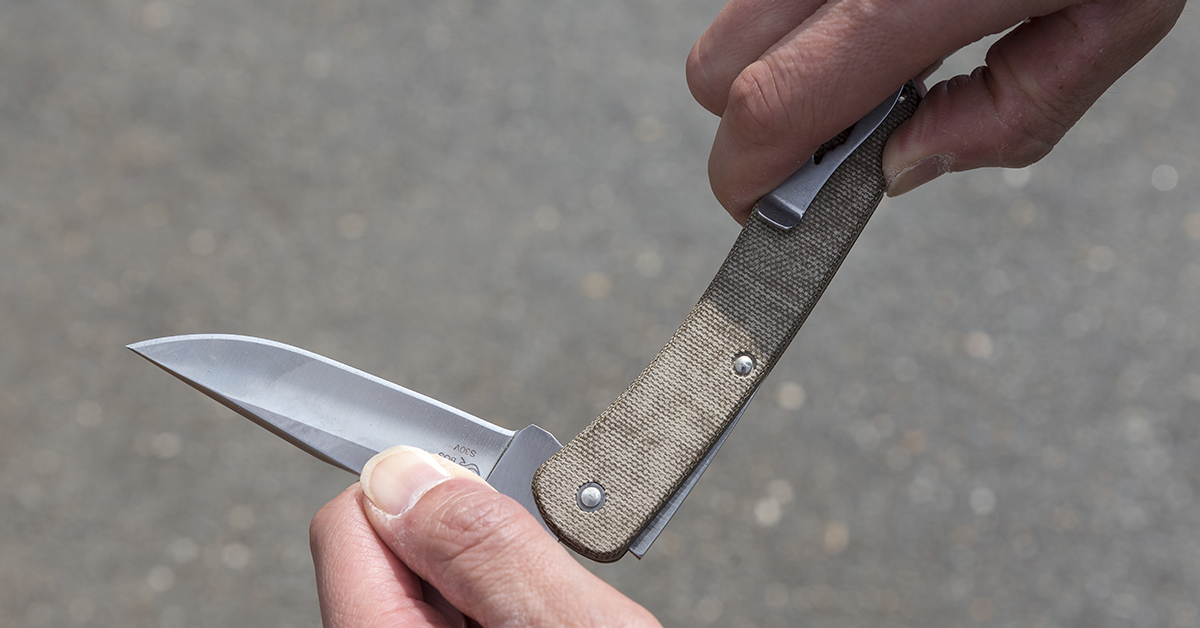
Usually at the end of the handle is a relief that exposes the lock bar and allows you to depress it with your thumb. On certain models of lockbacks, namely newer style designs, the relief is cut into the middle of the handle to allow one-handed unlocking and closing of the blade.
The lockback is simple to operate yet strong. All lockbacks emit an audible “click” sound when the tooth drops into the notch. Hearing this provides assurance that the knife is ready for use.
The lockback is perhaps the most common folder blade lock that you will see. With everything from tactical to outdoors/hunting to everyday carry to gentleman’s folders, this lock type bridges many styles.
One of the newest lockbacks on the market is Buck’s 110 Slim Pro. A variant of the legendary 110 Folding Hunter, the 110 Slim Pro takes the venerable 110 design and updates it for modern day carry with such upgrades like a high-performance CPM S30V stainless blade that has ambidextrous thumbstuds for easy one-hand opening with either hand. This workhorse blade is set into handles of lightweight yet strong micarta or G-10 that allows for a very slim profile for easy, “bulk-free” pocket carry. There’s also a pocket clip, eliminating the need to carry the knife inside of a belt sheath (as with the standard 110 Folding Hunter). MSRP is set at $94.00 for the 110 Slim Pro. Handle color options are: brown micarta, green micarta, or black G-10.
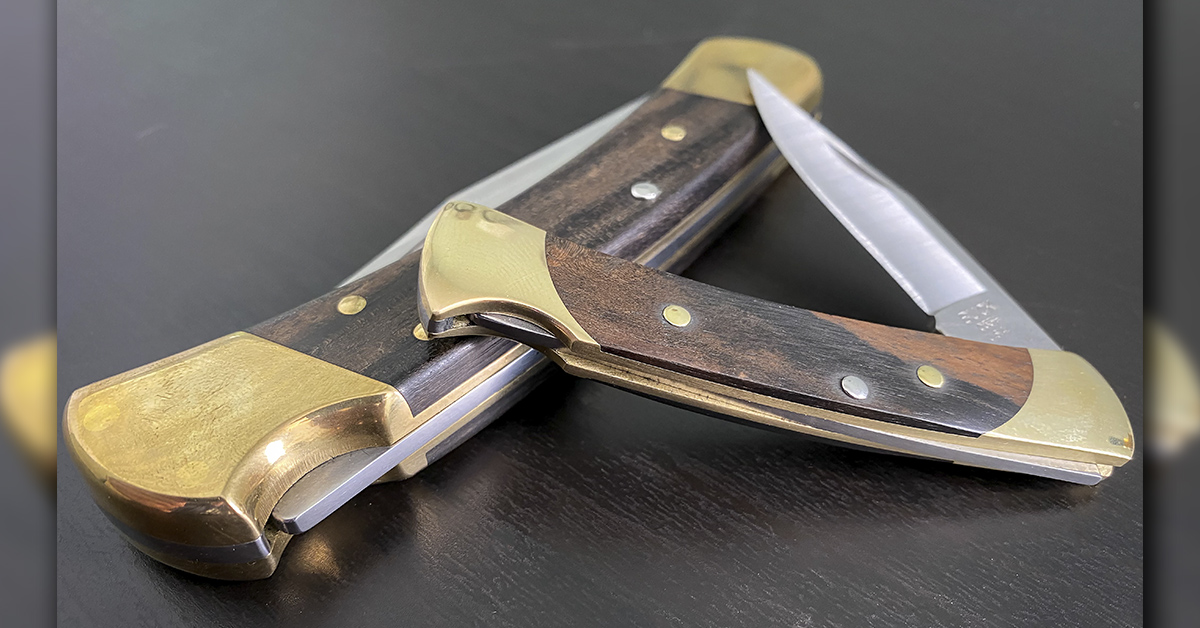
On the smaller side, Buck has their model 55 lockback. The 55 is about half the size of the 110, thus the model number. Employing 420HC stainless steel with a nice hollow grind, the 55’s clip point shape adapts to any cutting task you may have. The finer point is great for close-in work as well as for scoring. The hollow grind allows the blade to slip through a variety of materials with little resistance. While 420HC is a lower end steel, it is a steel that Buck uses a lot across their product line and they have the heat treat of this steel down. It holds an edge fairly well and is easy to resharpen. The handle is exactly like that of the 110. Crelicam genuine ebony wood is stabilized to prevent rotting and provides a nice, earthy hue. Double brass bolsters accent the handle and give the knife its heft. A lockback mechanism secures the blade just like the 110 Folding Hunter. So, what this amounts to is a pocket-sized 110 Folding Hunter that rides comfortably in the bottom of your pocket and has the capability of putting in serious work. Made in the USA in Buck’s Post Falls, Idaho, factory, the 55 carries on Buck’s legacy of manufacturing excellence of knives for the outdoorsman.
PROS: Easy to use, very secure, and is difficult to fail under normal use. Spring pressure also helps keep the blade closed.
CONS: Often requires two hands to unlock and close the blade. Doesn’t promote open blade spine construction for easy cleaning.
EXAMPLES: Buck 110, Spyderco Chapparal Lightweight, Boker Scout, Buck 110 Slim Pro, Kabar Dozier Folding Hunter, Gerber LST, Cold Steel Bush Ranger, and SOG Salute.
THE LINERLOCK
The next most common blade lock is called the linerlock. It operates on a different principle than the lockback and it is easier to close the knife one-handed than the lockback.
Linerlock gets its name from the way the lock is formed. It is cut and bent from the steel or titanium liner of the handle. The lock bar swings into place behind the blade tang as the knife is opened, thus blocking the blade from rotating closed. To release, take your thumb and depress the exposed portion of the lockback and this will move it out of the way so the blade can be rotated to the closed position.
Unlocking and rotating the blade closed can all be done with the same hand, thus making this lock style a popular choice for the modern one-hand opening and closing tactical folders and folding hunters. Used in conjunction with a thumb disk, ambidextrous thumb studs, or blade hole, the linerlock is truly a knife that can be deployed and put back into the pocket with the use of only one hand.
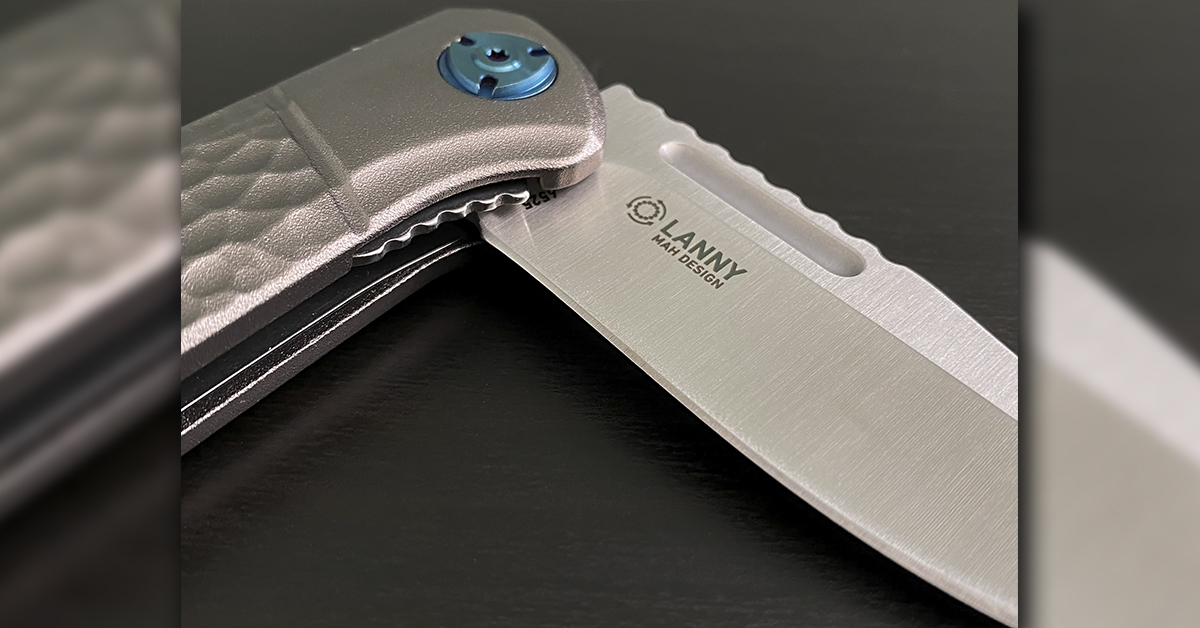
One word of caution, though. Due to how you unlock the linerlock by placing your thumb into the path of the closing blade, you must be extra careful to remove your thumb before you close the blade. Otherwise, expect to receive an accidental cut on your thumb as it meets the cutting edge when the blade rotates towards the closed position. This is one of the downfalls of this lock.
Linerlocks are found across the folding knife spectrum as well, equally at home in tactical, outdoors/hunting, everyday carry, and gents’ knives. A good example of a linerlock-equipped folder is the CRKT Lanny. Designed by renowned knife designer Liong Mah, the Lanny is a nod to the traditional Lanny’s Clip slipjoint folder pattern and updated with modern day conveniences such as assisted opening with a blade flipper tab, IKBS bearings in the pivot for ultra-smooth blade action, and a deep carry pocket clip. The blade measures a little over three inches long and is a drop point shape for high utility. Handles are aluminum and sport a textured machining pattern that simulates jig bone, and there’s the optical illusion of a bolster as well. The Lanny is equipped with blue anodized screws, pivot, handle spacer, and pocket clip to finish off the eye-catching look. MSRP is set for $89.99.
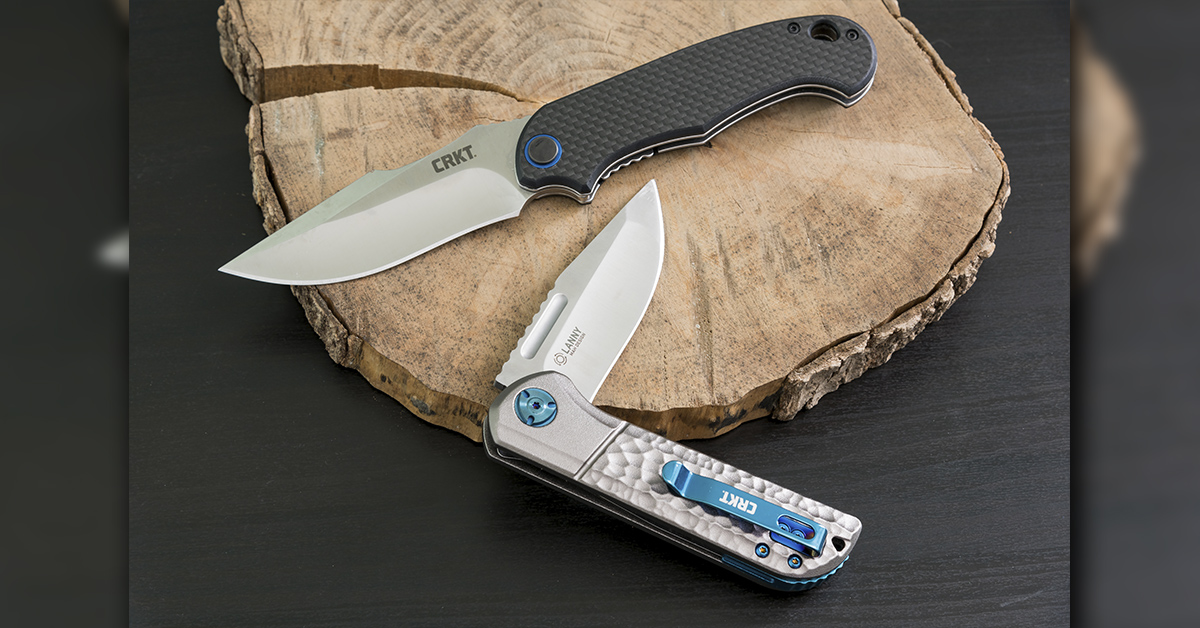
To illustrate tactical, there is the CRKT P.S.D., designed by custom knifemaker Jim Hammond. Hammond was the first custom knifemaker that CRKT worked with, and he still is associated with the company. The P.S.D. (Particle Separation Device) has an edgy look to it thanks to its 3.6-inch-long, recurve clip point blade with harpoon swedge. The steel of choice is 1.4116 stainless, which is a steel widely used in kitchen knives. The handle is ergonomically shaped to prevent forward or backward sliding of the hand. The blade is opened ambidextrously via the flipper tab and the assisted opening mechanism helps to propel the blade open quickly. Like the Lanny, the P.S.D. has an IKBS bearing system in the pivot for ultra-smooth blade rotation. The handle material is G-10 composite with a veneer layer of carbon fiber for a sophisticated, high-tech appearance. Put this all together and you have a knife that has multiple curves that add function as well as aesthetics. The MSRP of the P.S.D. is $99.99.
PROS: Easy to use, smooth blade rotation, one hand unlocking and closing.
CONS: Requires placement of thumb into the radial path of the blade closing—accidental cuts may be possible for those not familiar with the lock.
EXAMPLES: Kershaw 1830 Oso Sweet, Ontario RAT Model 1, Emerson Knives Sheepdog, Boker Plus Burnley Kwaiken, Benchmade 601 Jared Oeser Tengu, and Smith & Wesson Extreme Ops Karambit.
THE FRAMELOCK
The framelock is a close relative to the linerlock and operates in the same manner as the linerlock. The main different is the framelock lockbar is the same thickness as the handles. Like the linerlock, the lockbar is cut and bent from the handle. Linerlocks use a thinner metal liner while the framelock is beefy and has more mass to it. It places more metal behind the blade tang, often about the same thickness of the blade itself.
The framelock is highly regarded as a heavy-use lock due to its rock-solid nature. Many knife enthusiasts who use their knives hard often gravitate towards the framelock for its high reliability and low failure rate. Most framelocks are titanium, although some production models can be stainless steel. Stainless steel framelocks are more economical due to the lower cost of steel and the steel can be fine-blanked (stamped) as opposed to laser cut. Titanium is a more expensive material and requires CNC machining, which can be a costly process.
The steel handle framelocks are thinner to cut down on the weight and bulk of the knife but are just as strong as framelocks that have thicker handles. You’ll find steel framelocks in lower end production knives and titanium on the high-end ones. Framelocks are a staple in tactical folders but also are found in everyday carry knives that are smaller and desired for their thinness and robust nature.
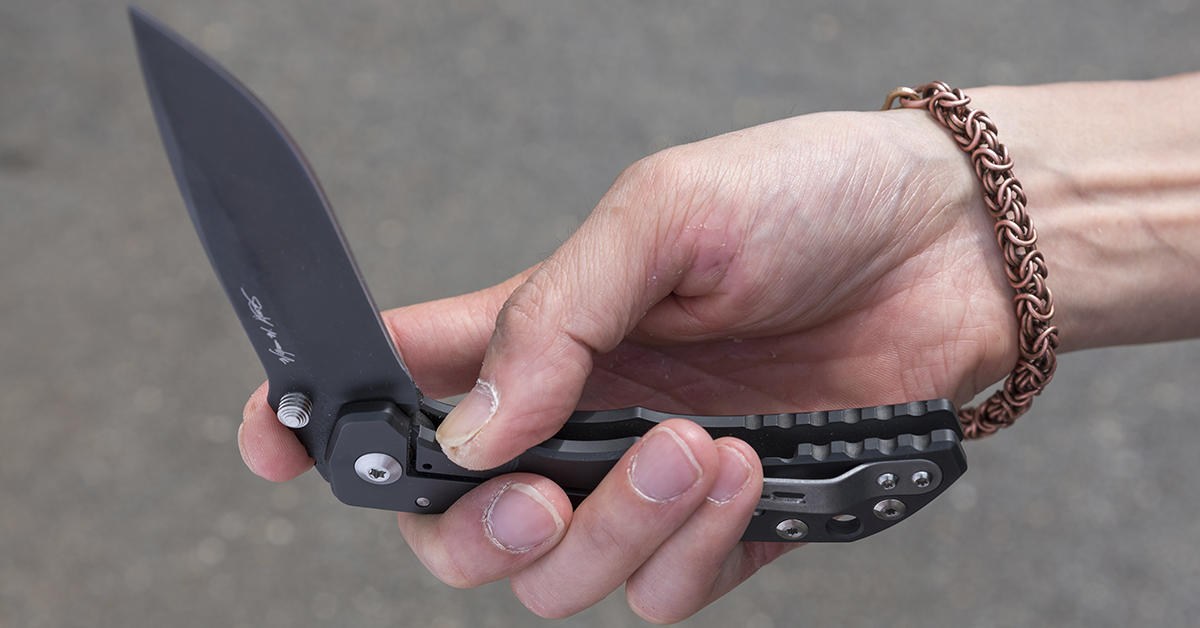
Great examples of framelock knives are the Spartan Blades SHF folders. Designed by custom knifemaker Bill Harvey, the SHF is a solid design that makes a great hard use folding knife. The full size SHF features a 4-inch blade made from CPM S45VN premium stainless steel for ultimate edge holding. The drop point shape accommodates a wide variety of cutting tasks, and the blade is opened by ambidextrous thumbstuds. The handle is all titanium and has a couple finger recesses that accommodate your grip comfortably and securely. A titanium pocket clip is mounted on the end of the handle for convenient tip-up carry in the pocket. Strategically placed jimping on the handle and blade spine thumb rest provide nonslip grip. Available in your choice of all stonewash ($460.00 MSRP) or all black PVD coated ($495.00 MSRP) finishes, the SHF is one of the bestselling high-end framelocks on the market.
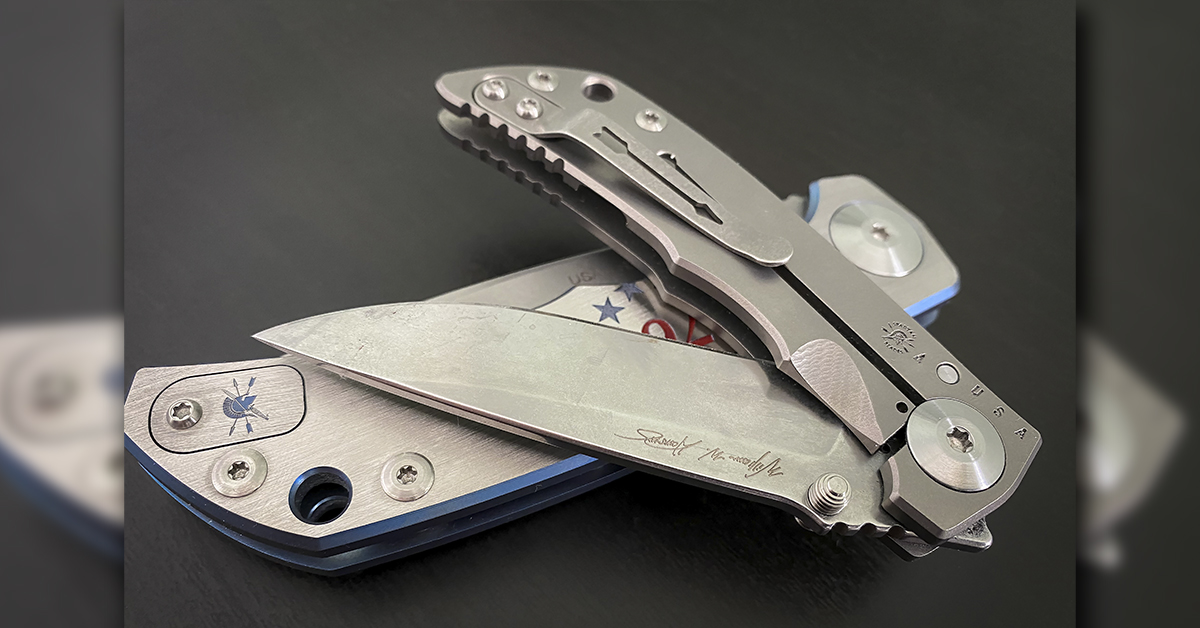
Ever since the full size SHF hit the market, Spartan Blades has received requests for a smaller version better suited for everyday carry. Finally, in 2020 they released the SHF 3.25. A scaled down version with a 3 ¼ blade, the 3.25 is built every bit as tough and solid as its bigger sibling. Less bulk and weight in the pocket, the SHF 3.25 is the answer for those who wish for a smaller size folder that has the brute strength of a larger one. Again, the same materials are used as the bigger SHF, with CPM S45VN stainless steel and titanium. Currently, only one finish is offered for the SHF 3.25 and that is a stonewash blade with bead blasted titanium handle. The MSRP is $395.00.
PROS: Very strong, robust, and ultra-secure lockup. Titanium for a good strength-to-weight ratio. Stainless steel is more economical, strong, and has a good heft.
CONS: Can be on the thick side. Titanium framelocks are expensive due to the cost of materials and the need for CNC machining.
EXAMPLES: Chris Reeve Sebenza, Kershaw Leek, Kizer Cutlery Gemini, Gerber Flatiron, CRKT Pilar III, Boker Plus Urban Trapper, and Zero Tolerance Hinderer 0562.
BUTTON LOCKS
The button lock mechanism is certainly not new; it’s been used on automatic opening tactical knives through the years. More recently, the button lock is being used in some manual opening knives as well. Whether manual or automatic opening, they work the same. The exception is with automatics. There is a coil spring in the pivot of the blade that creates tension as the blade is closed and depressing the button lock releases the blade for movement.
Button lock science is fairly simple. The button is at the top end of a shaft that extends into the handle of the knife. On the end that meets the blade tang, there is a tapered plug that engages a matching radial cutout in the blade tang. Once the plug finds this cutout, the button lock will spring up and wedge the plug inside the radial cutout. At this point, the blade is securely locked open until the user depresses the exposed button. That will move the entire shaft and thus the tapered plug moves away from the radial cutout, allowing the blade to be rotated safely to the closed position.
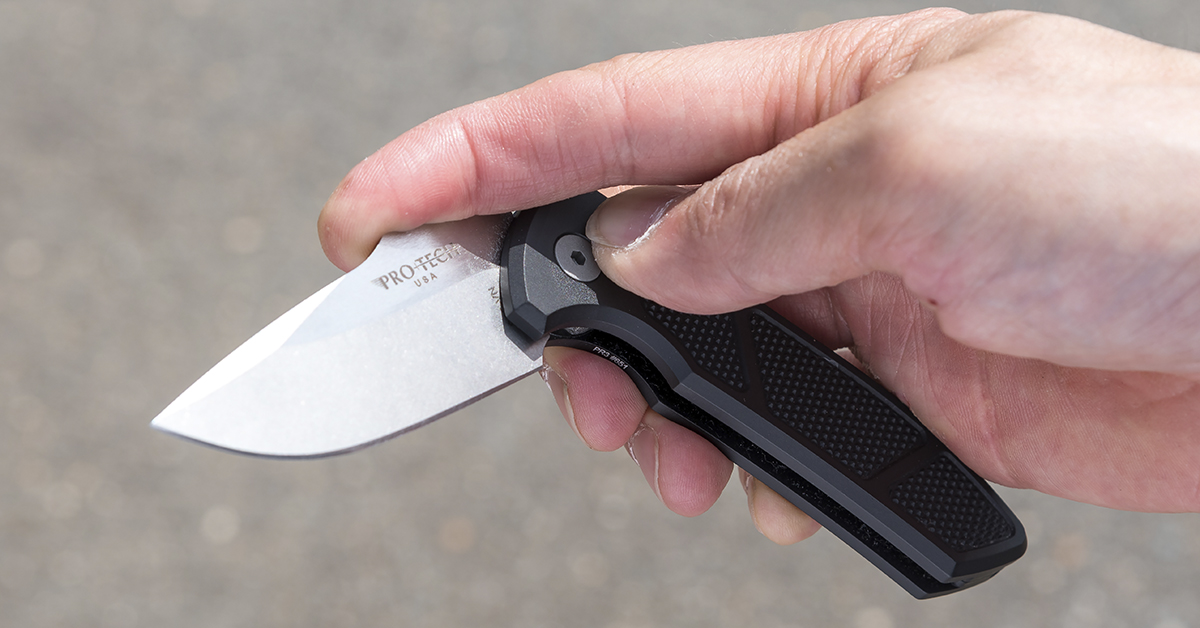
Conversely, there is a radial cavity machined into the blade so that this tapered plug will lightly catch when the blade is in the closed position. The detent is easily overcome with a bit of force required to open the blade. There is a strong coil spring placed into a hole in one of the handle scales, and this is what provides spring tension for the button lock shaft to allow it to operate in this manner.
The lock is, literally, two pieces only—a shaft and a spring. The button protrudes a bit on the handle, where it can be easily depressed by the thumb yet stay out of the way during normal use. The button itself can be machined with a pattern that permits positive contact with the thumb for disengagement or just left smooth.
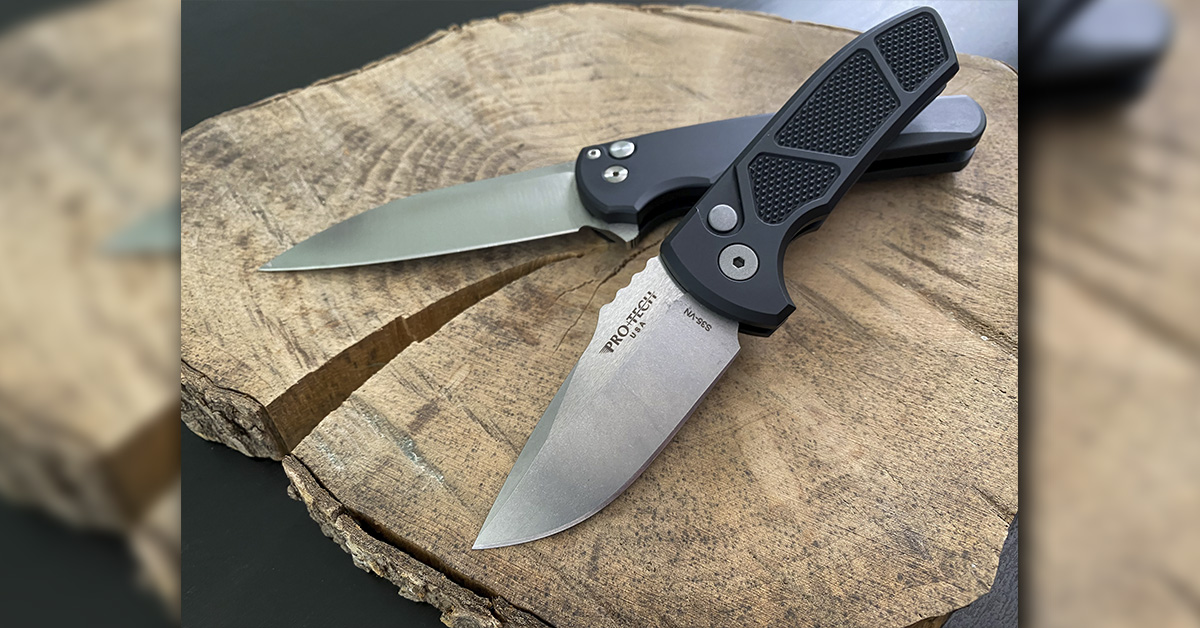
A good example of a couple button locks is the Pro Tech Malibu manual flipper and the company’s Les George designed SBR. The Malibu can be had in one of two blade shapes—Wharncliffe and reverse tanto. Regardless of shape chosen, the blades measure 3 ¼ inches in length and are flat ground from premium CPM 20CV stainless steel. Either is opened rapidly using the flipper tab in conjunction with the blade riding on bearings for ultra-smooth movement. Handles are made from 7075 aluminum and are given a hard coat anodized finish in a choice of blue or black. A deep carry pocket clip carries the Malibu tip up in the pocket. With an MSRP of $270.00 for either blade version, the Malibu is a great value for a high-end folder that is one of the company’s hottest sellers.
The SBR was designed by custom knifemaker Les George and it is a compact version of his existing Rockeye automatic folder that has been in production by Pro Tech. The SBR (Short Blade Rockeye) is a compact folder with attitude. It’s 2 ½ inch clip point blade is machined from CPM S35VN stainless steel and has a swedge as well as a thumb rest that has traction notches for secure thumb placement during use. The handle is made from 6061 aluminum and is anodized black. The base model SBR features a smooth aluminum handle, but an upgraded version has milled-in knurling to add hand traction. With a press of the button lock, the SBR’s blade opens with authority and the lockup is secure. The SBR proves that small knives with a big attitude make perfect daily carry folding knives. The base model SBR has an MSRP of $240.00 and the prices increase from there depending on handle and blade options. All Pro Tech knives are made in the USA in their facility in Placentia, CA.
PROS: More intuitive to operate, safer to operate because fingers don’t traverse the radial path of blade movement, and stronger. Blade detent in the closed position is more positive than linerlocks.
CONS: Some locks have internal springs that might break and need replacement
EXAMPLES: Gerber Propel Assisted Opening, CRKT McGlaun Clever Girl, Boker Magnum BKT, Gerber US Assist.
NEXT GENERATION BLADE LOCKS
There is constant innovation happening in the knife industry, and this is how knives have progressed through the years with improvements to designs, materials, blade steels, and blade locks. Keep in mind, there’s nothing wrong with the lockback, linerlock, or framelock. All three are solid and highly reliable locks that have been used for years and continue to be used widely. There are a couple companies who have pushed the envelope to come up with stronger blade locks that are even more user friendly. They prove that you can build a better mousetrap that is also safer to use than the three previously mentioned locks.
Benchmade Axis Lock
Introduced in 2000, the Benchmade Axis Lock was truly a groundbreaking innovation for Benchmade. It first appeared in the Benchmade product line in the form of the company’s now discontinued model 710 Axis Lock folding knife. Developed by custom knifemaker Bill McHenry and Jason Williams, the totally ambidextrous Axis Lock incorporates a steel lock bar that is positioned in a channel in the handle. The lock bar travels in a fore and aft position inside the channel while under constant spring tension provided by dual omega-shaped springs—one on each side of the lock bar. The lock bar is in contact full time with the specially shaped blade tang, and when the blade reaches the open position, the tang flattens out and at that point, allowing the lockbar to spring forward and wedge itself between the handle’s dual steel liners and the tang, preventing the blade from being closed.
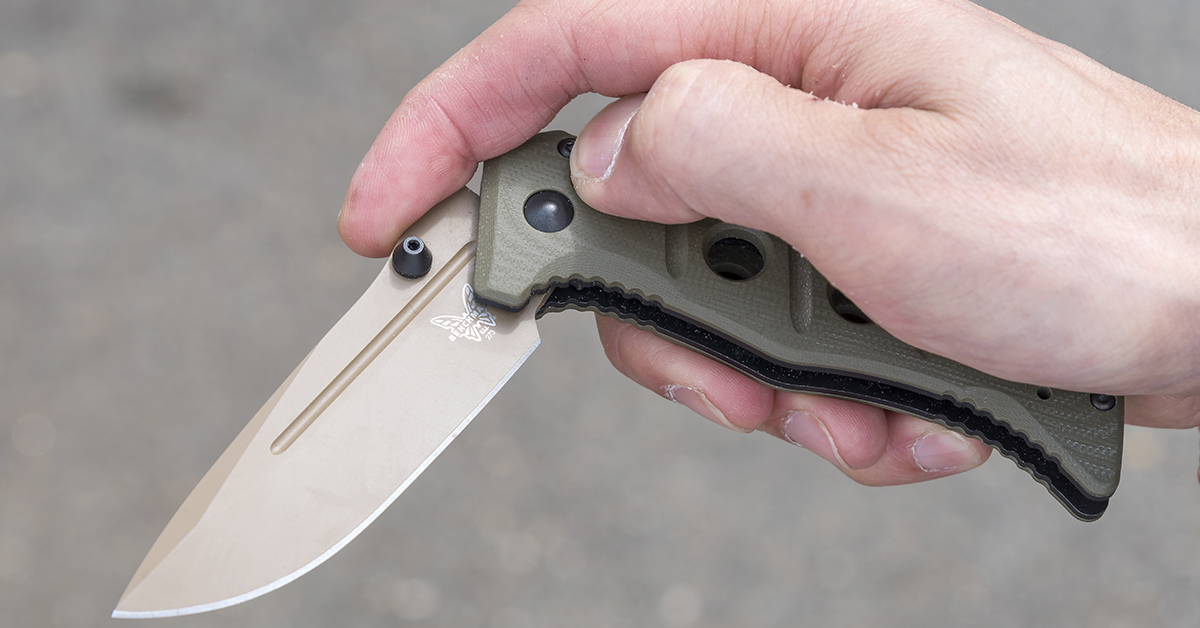
The Axis Lock provides an incredibly solid lockup and will self-compensate for any wear that may occur over time.
To close the blade, hold the handle securely with one hand and, with your thumb, pull downward on the Axis Lock bar. That will move the lockbar out of the way of the tang. At the same time, take your index finger and gently initiate the blade’s rotation towards close and then take your thumb and guide the blade to the fully closed position by placing it on the blade spine. Really, it’s easier than it sounds, and anyone can manipulate the Axis Lock with a little practice.
The Axis Lock is a safer lock because to close it, you do not place any fingers in the radial path of the closing blade. Since the release of the Axis Lock, Benchmade has really run far with this lock, incorporating it into many of the company’s folding knives that are aimed at tactical, outdoors/hunting, everyday carry, and rescue knives. They have even incorporated it into their assisted opening folders as an Auto Axis Lock mechanism for automatic opening knives whose blades are released not by a button like regular automatic knives are but by pulling back on the Axis Lock bar and releasing the blade to open quickly under spring tension.
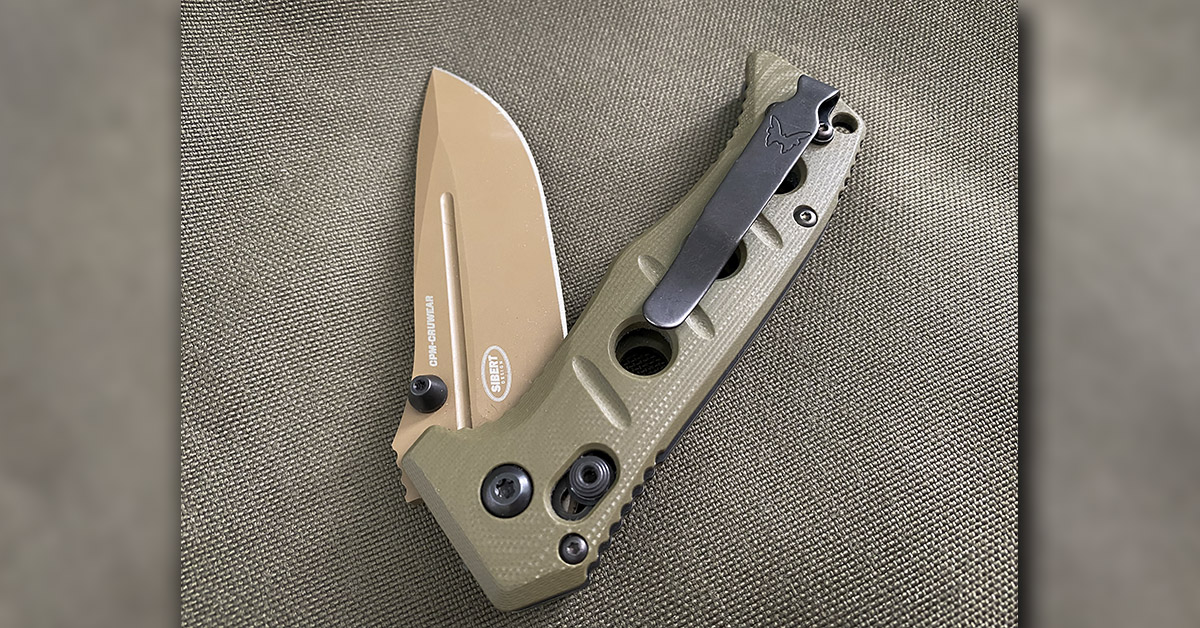
Benchmade came through with another surprise in 2001 when they incorporated the Axis Lock into their then new Griptilian series of folders, making the Axis Lock available for the first time in a knife that had an MSRP below $100.
The Griptilian has become one of the bestselling knives in Benchmade history. One of Benchmade’s latest folders equipped with the Axis Lock is their 273FE-2 Mini Adamas. Custom knifemaker Shane Sibert designed the Mini Adamas. The little brother to the larger model 275 Adamas, it takes the same sturdy nature and scales it down for a more comfortable carry, with a blade length of 3 ¼ inches long. The drop point blade is ground from CPM CRU-WEAR tool steel for the ultimate in toughness and edge retention. Because the steel is not stainless, the 273FE-2 is given a Flat Earth PVD coating to guard against corrosion. Handles are OD green G-10, and the tip up carry pocket clip can be mounted to the opposite side of the handle for comfortable carry by lefties. The MSRP for the Mini Adamas 273FE-2 is $250.00.
Gerber Pivot Lock
They say imitation is the sincerest form of flattery. If true, then the Axis Lock is extremely flattered. Why? Because it has spawned quite a few locks that are similar in construction and operation.
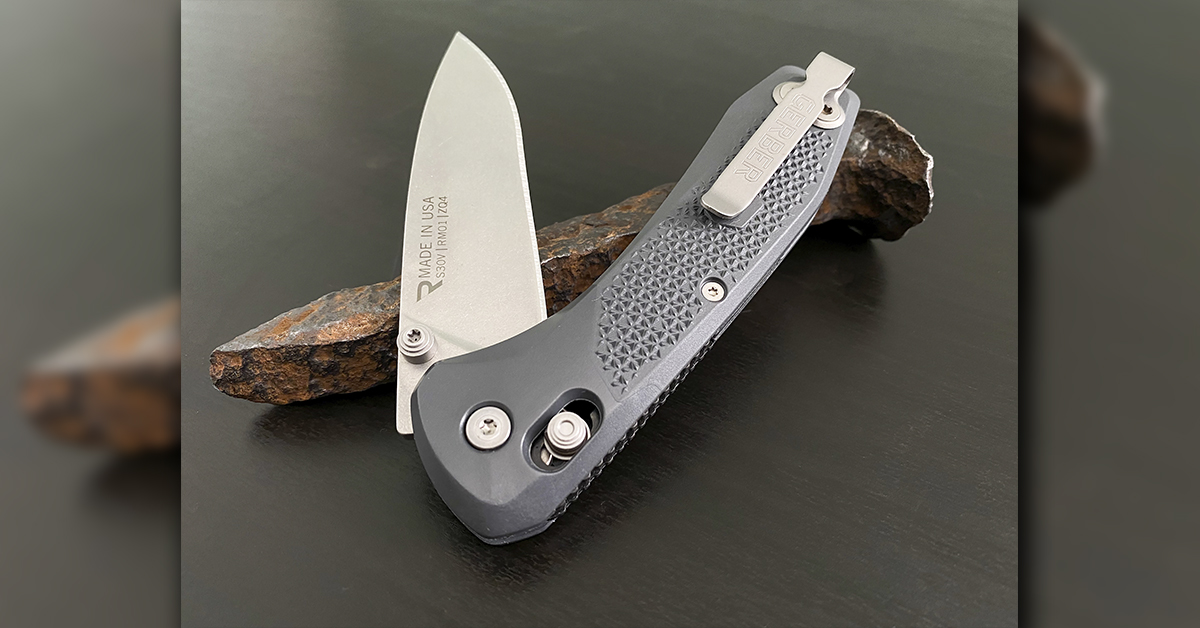
Gerber’s Sedulo folder is part of the company’s Reserve series of small batch production knives. The Sedulo features a textured and molded handle with an S30V drop point blade. The blade lock is what Gerber calls the Pivot Lock. With an MSRP of around $100, the Sedulo represents the same value and innovation as the Benchmade Griptilian. The Sedulo is available in several configurations, including a black handle with stonewashed blade, a gray handle with stonewashed blade, all black blade and handle, and urban blue handle with black blade. This knife offers innovation and made in USA quality—all at a great price.
Hogue Knives ABLE Lock
Hogue Knives offers their ABLE Lock with the acronym meaning “Ambidextrous Bar Lock Enhanced.” This lock is found on several models of Hogue’s knives, such as the Deka, SIG K320, HK Exemplar, and the Doug Ritter RSK Mk1 G2. All these knives cover everyday carry, tactical, and outdoors, which showcases the versatility of the ABLE Lock.
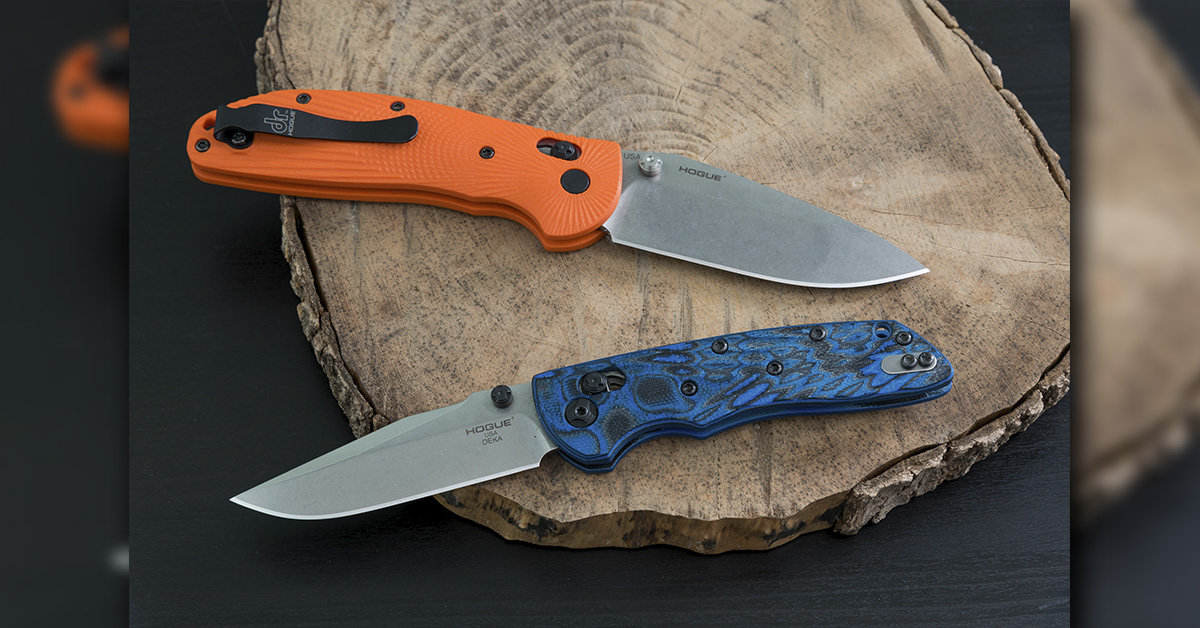
The Doug Ritter RSK Mk1 G2 is exclusively manufactured for Knifeworks, a Hogue dealer in Louisiana. It was designed by Doug Ritter, a noted outdoors authority and chairman of Knife Rights—a non-profit advocacy for sensible knife laws in the US. Ritter’s goal for such a knife was to create a folder that is robust enough for camp chores and be a general working folder. Two sizes are available for the RSK Mk1 G2—one with a 3.5-inch blade of CPM 20CV stainless and a smaller one with a 2.9-inch blade, also of CPM 20CV. Handles are available in three colors: black, orange, and tan. G-10 is the material of choice, and the ergonomic shape is comfortable to use for extended periods. The G-10 has a sunray-type machining pattern on it for hand traction. Blades are available in stonewash or black blades. Either size Ritter RSK Mk1 G2 comes with deep carry pocket clips for the ultimate carry convenience.
Spyderco Compression Lock
Introduced in 2000, the Spyderco Compression Lock along with the Benchmade Axis Lock represented the best in forward-thinking mechanical innovation in the knife industry. The Compression Lock quickly established Spyderco as a major player in the new generation blade locks category. It uses a split liner akin to that of a liner lock, but that’s where the similarities end.
As it relates to the blade, the linerlock engages at the end of the blade; the Compression Lock engages the top of the blade in line with the blade spine. The engagement of the lock is below the stop pin and takes full advantage of that.
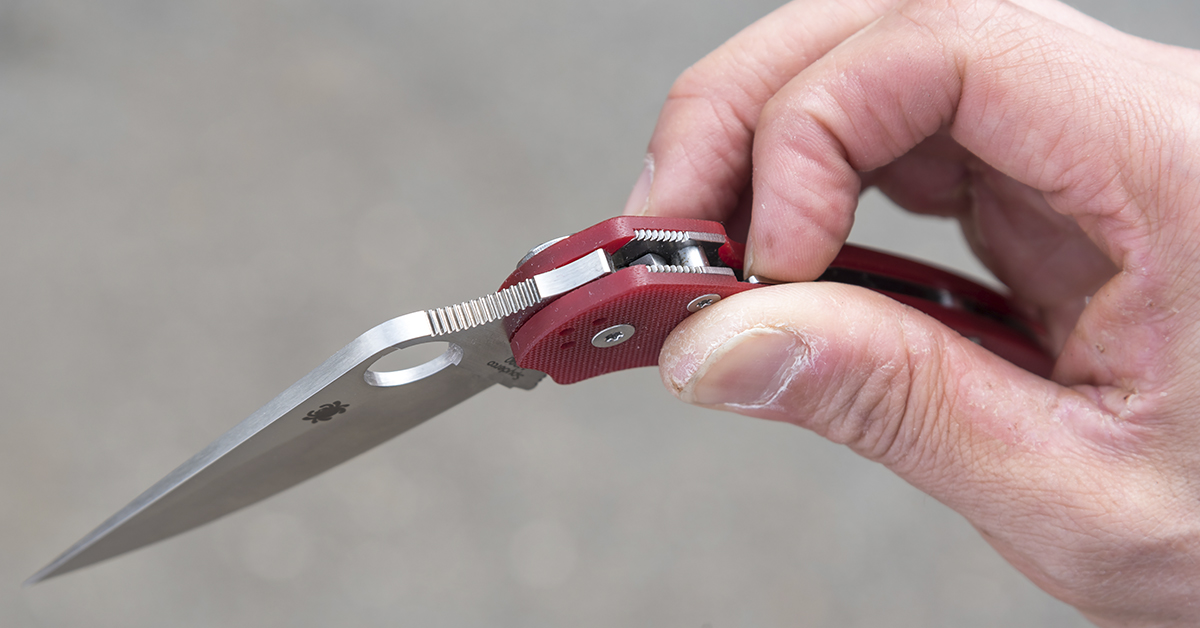
When the blade is opened, the integral lock bar of the Compression Lock swings into place and engages a ramped portion of the blade tang (similar to how a linerlock operates). The top part of the lockbar physically engages the stop pin, so at this point, it is effectively wedged into place between the stop pin and the ramped portion of the blade tang. When downward force is applied to the spine of the blade, the lock cannot be defeated because it must compress the width of the lockbar, hence, the name.
Like the liner lock, there is a cutout on the handle to allow easy access to disengage the lock with your index finger. Pinch the handle with your thumb, middle finger, and ring finger. Your index finger comes to rest on the exposed Compression Lock release. Press with your thumb to unlock and at the same time give the handle a tilt and that will cause the blade to fall closed into the handle under the force of gravity. You don’t need to touch the blade to initiate movement so none of your fingers traverse the radial blade path. Accidental cuts are eliminated!

Not only is the Compression Lock a stronger lock design but it is safer as well. It might look a bit odd at first, but I guarantee once you fiddle with one and see how it works and how to work it, you will be an immediate fan of this lock design.
Spyderco’s Paramilitary 2, aka Para2, is one of the company’s best sellers right now because it is a midsize folder that is made from premium materials and has the Compression Lock. The 3 ½ inch clip point blade is flat ground from CPM S30V stainless steel for the ultimate edge retention. The ergonomic handle is black G-10 and has features like an integrated hand guard, finger coil, and a four-position pocket clip that can be mounted to carry the Para2 tip up or tip down, left-handed, or right-handed. Made in Spyderco’s factory in Golden, CO, the Paramilitary 2 has an MSRP of $225.00.
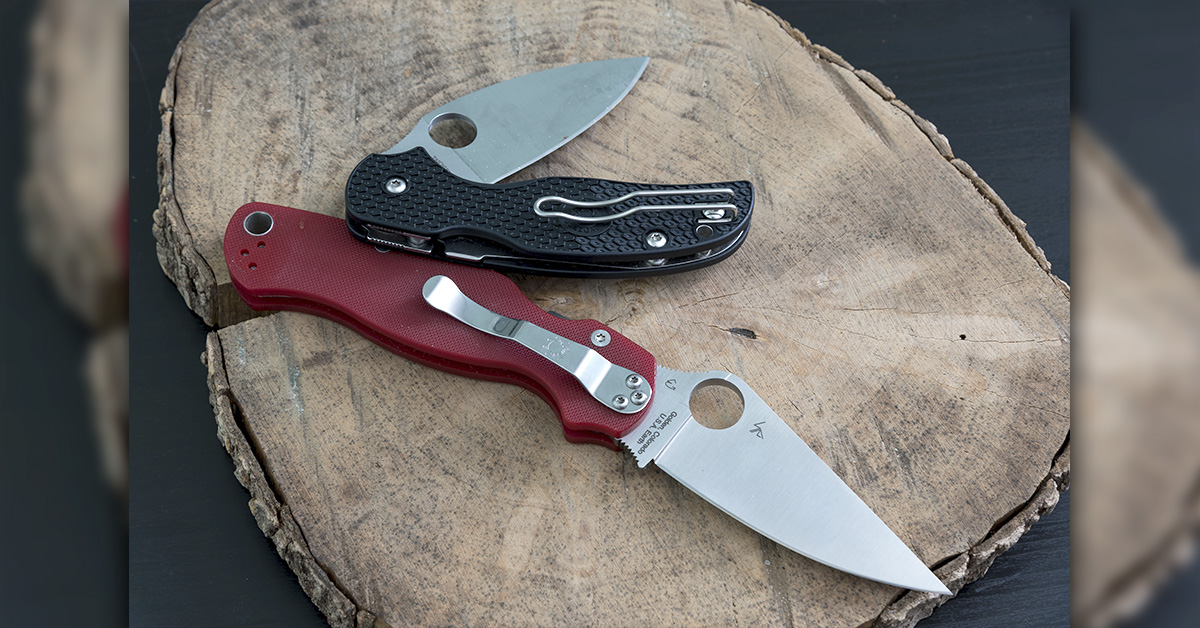
If smaller knives are more your pace, check out the Sage 5 Lightweight. It is a small, thin, and lightweight folder that also packs a punch with its 3-inch leaf-shaped, flat ground CPM S30V steel. The ergonomic handle has nested steel liners which provide a solid backbone and integrates the Compression Lock. Handle scales are injection molded FRN (fiberglass reinforced nylon) and sport a unique bi-directional texturing that Spyderco has pioneered for their FRN handle folders. This design provides not only an effective non-slip grip but a unique appearance as well. The blade rides on a specially designed bushing that promotes glassy smooth blade operation. A sturdy and fashionable wire pocket clip easily carries the Sage 5 Lightweight. With an MSRP of $175.00, the Sage 5 Lightweight packs a lot of innovation for the price. It is made in Taichung, Taiwan, and sports the typical high quality that Spyderco is known for.
Like everything else in life, from computers to wireless phones, from automobiles to sporting goods, folding knives have evolved considerably over the years. Blade locks have made folders safer to use and with the new generation blade locks, folding knives are safer to use than ever.


